Sold Ceramics
Sold Chinese Imari 1700-1800
Flowers, Animals and Long Elizas
Page 1
Chinese porcelain producers developed new types of decorations in the early 18th century, Chinese Imari being one of them. It is characterised by a combination of underglaze blue and overglaze red and gold. Details are sometimes in black and green enamels. This development was a reaction to the success of Japanese Imari porcelain with a similar colour scheme. Sometimes Chinese imitations are direct copies of Japanese examples but more often Chinese Imari is decorated with typical Chinese motifs that are closely related to the underglaze-blue patterns of the period. However, the use of red and gold makes Chinese Imari more lavish. Landscapes, flowering plants, birds and mythical creatures are recurring motifs. Depictions of humans are less frequent and apart from armorial pieces, European designs are quite rare. The shapes fit into the normal export assortment. Chinese Imari was not only in demand in the West, but also in south-east Asia, India, and the Ottoman Empire. In the VOC (Dutch East India Company, 1602–1799) records it is called 'Chinese-Japanese' and in addition to blue and white and enamelled wares, this was a standard type in the Company's assortment that was bought in Canton until the end of the 18th century.

Sold Ceramics - Sold Chinese Imari 1700-1800 - Flowers, Animals and Long Elizas - Page 1
Object 2011025
Dish
China
1700-1720
Height 35 mm (1.38 inch), diameter of rim 265 mm (10.43 inch), diameter of footring 145 mm (5.71 inch)
Dish on footring with a border of interlocking open rings and an underglaze brown-edged rim (jia mangkou). Chinese Imari, decorated in underglaze blue, iron-red and gold with flowering plants around a pheasant on a rock, enclosed by a small zig-zag lines pattern border with eight reserves filled with flowers. On the sides four auspicious symbols with ribbons and flower sprays. The rings coloured iron-red, pale pink and green in sequence. On the reverse two flower sprays.
The border of interlocking rings is known from early 18th century famille verte pieces. This kind of rim was probably specially developed for the European market. When the dish was finished, the pattern was traced onto the dish with a stencil after which the circles were cut from the leather-hard clay. It is less frequently used on Chinese Imari plates and dishes so this piece can be considered a fine and rare example, This kind of rim seems to have been abandoned around 1750, probably because it was to expensive. At times it was also imitated in European porcelain, in particular Bow and Worcester. It is interesting to note that Japanese Imari pieces are also known with such borders, shallow bowls in particular. (Jörg 2003/1, p.115)
For identically decorated dishes, please see:
- Chinese Ceramics in the Collection of the Rijksmuseum Amsterdam. The Ming and Qing Dynasties, (C.J.A. Jörg in collaboration with J. van Campen, Rijksmuseum Amsterdam, London 1997), page 203, cat. 227.
- Chinees porselein en aardewerk, (D.F. Lunsingh Scheurleer, De Haan, Bussum, 1972), pl.146.
- The Hodroff Collection, Part II, auction catalogue Christie’s New York, 23th of January 2008, sale 1958, p.83 lot 380.
For identically, with famille verte enamels decorated dishes, please see:
- Chinese Ceramics in the Collection of the Rijksmuseum Amsterdam. The Ming and Qing Dynasties, (C.J.A. Jörg in collaboration with J. van Campen, Rijksmuseum Amsterdam, London 1997), page 156, cat. 169.
- Ceramics crossed overseas. Jingdezhen, Imari and Delft from the Collection of the Groninger Museum, (C.J.A. Jörg et al., Tokyo, 1999), p.54, cat. 64.
- Famille Verte, Chinese Porcelain in Green Enamels, (C.J.A. Jörg, Schoten 2011), p.48 cat. 48.
For a Japanese Imari shallow bowl with an open-worked rim of interlocking rings, please see:
Condition: A frit to the footring.
References:
Lunsingh Scheurleer 1972, pl. 146
Lunsingh Scheurleer 1977, cat. 184
Lunsingh Scheurleer 1982, cat. 90
Jörg & Van Campen 1997, cat. 171 & 227
Price: Sold.
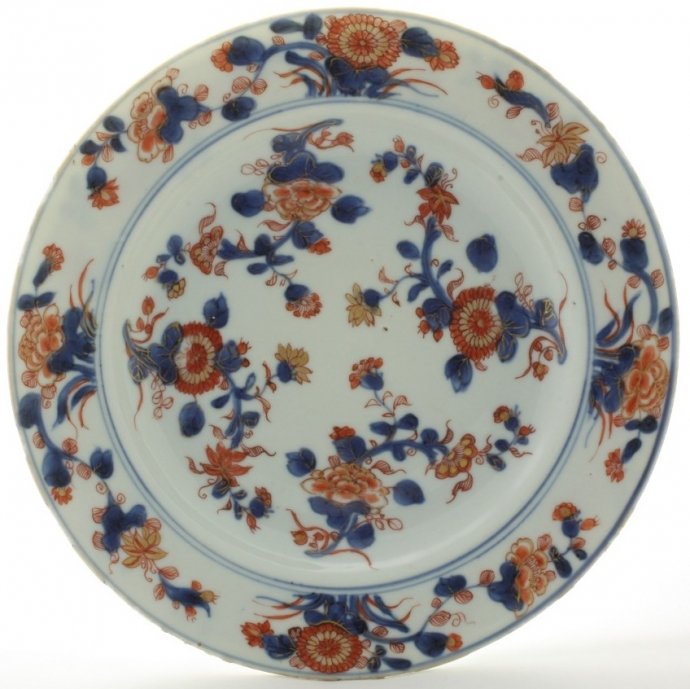
Sold Ceramics - Sold Chinese Imari 1700-1800 - Flowers, Animals and Long Elizas - Page 1
Object 2010342
Dish
China
1700-1720
Height 27 mm (1.06 inch), diameter of rim 225 mm (8.86 inch), diameter of footring 110 mm (4.33 inch)
Dish on footring, flat rim. Some kiln-grit adhering to the footring. Chinese Imari, decorated in underglaze blue, overglaze iron-red and gold with two flowering chrysanthemum and peony plants. On the rim two flowering chrysanthemum and two flowering peony sprays. On the reverse a continuous flowering peony scroll.
Condition: A firing flaw and a rough rim due to heavy glaze chips.
Price: Sold.
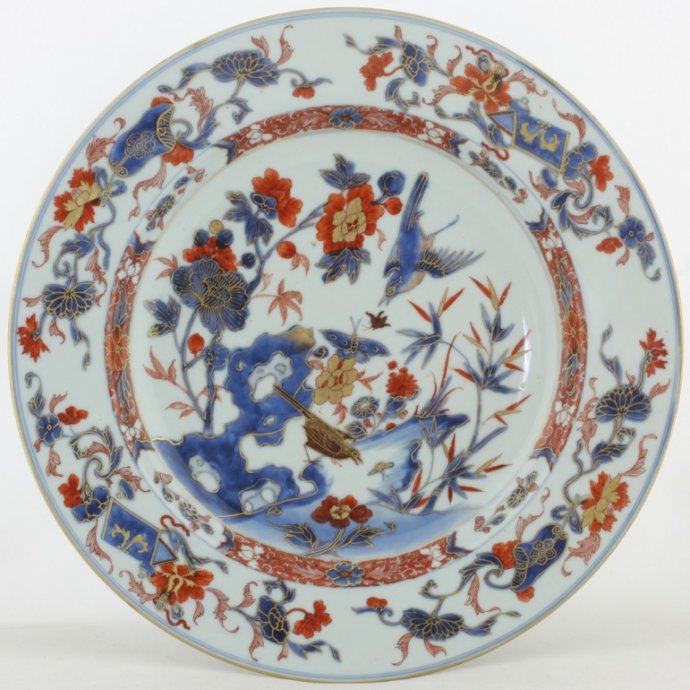
Sold Ceramics - Sold Chinese Imari 1700-1800 - Flowers, Animals and Long Elizas - Page 1
Object 2011639
Dish
China
1710-1730
Height 39 mm (1.46 inch), diameter of rim 285 mm (12.72 inch), diameter of footring 153 mm (7.09 inch), weight 587 grams (20.71 ounce (oz.))
Dish on footring, flat underglaze brown-edged rim (jia mangkou). Chinese Imari, decorated in underglaze blue, overglaze iron-red and gold with in the centre flowering peony, bamboo and chrysanthemum plants growing from taihu (garden) rock with two birds, one fin flight and one perched on a rock, a butterfly and small insects in flight. On the sides dense foliate scrolls reserved on an iron-red ground which incoporate a flower head between leaves alternating with four cartouches filled with chrysanthemum flower sprays. On the rim chrysanthemum flower sprays with antiquities alternating with peony flower sprays with antiquities. On the reverse two flower sprays.
The decoration on this dish is extremely well preserved with (almost) no wear at all to Chinese Imari (gold) decoration.
Condition: A Y-shaped hairline to the base and a chip to the inner footring.
Reference:
Price: Sold.

Sold Ceramics - Sold Chinese Imari 1700-1800 - Flowers, Animals and Long Elizas - Page 1
Object 2011996
Dish
China
c.1720
Height 26 mm (1.02 inch), diameter of rim 223 mm (8.78 inch), diameter of footring 117 mm (4.61 inch), weight 305 grams (10.76 ounce (oz.))
Dish on footring, flat underglaze brown-edged rim (jia mangkou). Chinese Imari, decorated in underglaze blue, overglaze iron-red, black and gold. In the centre a Chinese garden scene with a flowering peony plant and a large bamboo tree with a Lady on a swing looking down at a little dancing boy. On the sides a trellis pattern border with four flower heads. On the rim large incised lotus flower buds with a small border with floral elements. The reverse with two bamboo sprays.
Chinese Imari or "Chinese Japanese" as it is referred to in the Dutch East India Company, (Vereenigde Oost-Indische Compagnie, VOC) archives, was actually the Chinese answer to the popular Japanese Imari (after the port in Japan from which they were shipped), with its underglaze blue, iron-red and gold, that was produced in Arita for export from c.1680. This unusual dish is an interesting piece. On it the Chinese porcelain painter combined the underglaze blue and incised decoration with a 'Red & Gold' / 'Rouge-de-fer' decorating style with iron-red, black enamel and gold on the glaze, making it rare and unusual. (Jörg 2002/2, p.119)
The incised pattern is barely discernible to the naked eye unless the ware is held up to the light. The incised recesses have been filled with a transparent glaze to create a flat surface. The Chinese call this technique anhua (hidden decoration). (Emden 2015/1, p.132, cat. 122)
Condition: A glaze rough spot and a hairline to the rim.
References:
Price: Sold.
More pictures of object 2010450 another identically shaped, sized and decorated, sold dish >>
More pictures of object 2011870 another identically shaped, sized and decorated, sold dish >>

Sold Ceramics - Sold Chinese Imari 1700-1800 - Flowers, Animals and Long Elizas - Page 1
Object 2011737
Miniature double-gourd vase
China
c.1700
Height 61 mm (2.40 inch), diameter of mouthrim 10 mm (0.39 inch), diameter of footring 16 mm (0.63 inch), weight 28 grams (0.99 ounce (oz.))
Small double-gourd vase on footring. Chinese Imari, decorated in underglaze blue, overglaze iron-red and gold with flowering plants. On the neck two flower sprays.
At the beginning of the 18th century, there was a fashion among wealthy Dutch ladies to have models made on the scale of a house, the so called "doll's houses". The rooms of these doll's houses were furnished with miniature pieces of porcelain, furniture, paintings, upholstery and all other sorts of objects that would have belonged to the interior of a wealthy home. These doll's houses were very costly and certainly not meant for children to play with but were proudly displayed for friends and visitors and regarded as extremely luxurious items - counterparts of the cabinets of curiosities that were a fashionable hobby of rich men. Only a few of these doll's houses have been preserved. One example can be found in the Gemeentemuseum in The Hague showing an 18th century room with porcelain miniatures in cupboards and on brackets along the wall. In reality the majority of these "miniature doll's house vases" would have been part of the interior. A good example of an authentic porcelain room is the famous cabinet in Pommersfelden Castle, Germany, where groups of pieces on brackets are surrounded by these miniature vases lining the borders of the consoles. (Jörg & Flecker 2001, pp.50-51)
Condition: A firing flaw to the neck and heavy wear to the gold decoration.
Reference:
Price: Sold.
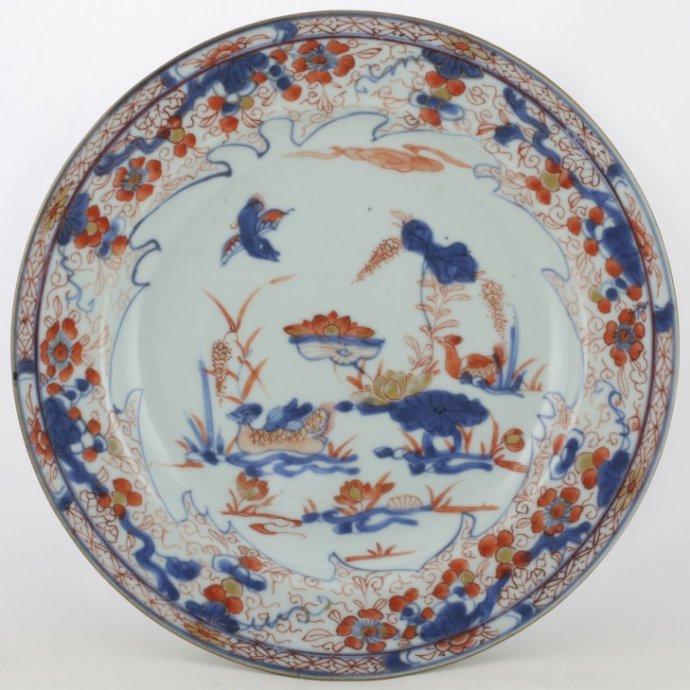
Sold Ceramics - Sold Chinese Imari 1700-1800 - Flowers, Animals and Long Elizas - Page 1
Object 2011855
Dish
China
1720-1730
Height 25 mm (0.98 inch), diameter of rim 220 mm (8.66 inch), diameter of footring 110 mm (4.33 inch), weight 346 grams (12.20 ounce (oz.))
Dish on footring, flat underglaze brown-edged rim (jia mangkou). Chinese Imari, decorated in underglaze blue, overglaze iron-red and gold with a central, flower-shaped, medallion filled with a flying duck and a pond with lotus flowers and two swimming ducks. On the sides flower sprays with leafy scrolls. Around the rim a diaper pattern ground with a single flower head between four reserves filled with a flower head. On the reverse three flower sprays.
Chinese Imari usually confined itself to iron-red, underglaze blue, and gold, but occasionally it was enriched with famille verte panels. It was based on the Japanese wares of a similar type made in the Arita kilns and exported to Europe in enormous quantities from the port of Imari in the Southern Island. (Boulay 1984, p.252)
The production of Chinese Imari starting in the early years of the 18th century, reached its peak in the 1720s and 1730s, but became formalised and repetitive in the next decades. Although Chinese Imari was primarily produced for export, it may be noted that there are some pieces in this style in the Palace Museum, Beijing. If these really were part of the imperial collection and not later additions, they are an indication that Chinese Imari was also appreciated by the Chinese an probably served as some kind of "Western" exotic ware. (Jörg & Van Campen 1997, pp.199-200)
Condition: A tiny fleabite to the reverse rim.
Reference:
Jörg & Van Campen 1997, pp.199-200
Price: Sold.

Sold Ceramics - Sold Chinese Imari 1700-1800 - Flowers, Animals and Long Elizas - Page 1
Object 2012098
A double gourd miniature "doll's house" vase
China
1700-1720
Height 70 mm (2.76 inch), diameter of mouthrim 7 mm (0.28 inch), diameter of footring 15 mm (0.59 inch), weight 38 grams (1.34 ounce (oz.))
Small double-gourd miniature "doll's house" vase, on a flat unglazed base. The rim in underglaze brown (jia mangkou). Chinese Imari, decorated in underglaze blue, overglaze iron-red and gold with flowering Aster and grasses alternating with an insect in flight. Round the neck two single branches.
At the beginning of the 18th century, there was a fashion among wealthy Dutch ladies to have models made on the scale of a house, the so called "doll's houses". The rooms of these doll's houses were furnished with miniature pieces of porcelain, furniture, paintings, upholstery and all other sorts of objects that would have belonged to the interior of a wealthy home. These doll's houses were very costly and certainly not meant for children to play with but were proudly displayed for friends and visitors and regarded as extremely luxurious items - counterparts of the cabinets of curiosities that were a fashionable hobby of rich men. Only a few of these doll's houses have been preserved. One example can be found in the Gemeentemuseum in The Hague showing an 18th century room with porcelain miniatures in cupboards and on brackets along the wall. In reality the majority of these "miniature doll's house vases" would have been part of the interior. A good example of an authentic porcelain room is the famous cabinet in Pommersfelden Castle, Germany, where groups of pieces on brackets are surrounded by these miniature vases lining the borders of the consoles. (Jörg & Flecker 2001, pp.50-51)
Among the ceramic cargo of the Ca Mau shipwreck (1725) identical shaped miniature doll's house vases decorated with stylised flowers and foliage within fine borders were found. (Amsterdam 2007, p.186)
Condition: Firing flaws to the body and foot.
References:
Price: Sold.

Sold Ceramics - Sold Chinese Imari 1700-1800 - Flowers, Animals and Long Elizas - Page 1
Object 2010119
Dish
China
1720-1735
Height 24 mm (0.95 inch), diameter 215 mm (8.47 inch), diameter of footring 110 mm (4.33 inch)
Dish on footring, moulded, egg-shaped, panels in low relief on the rim. Chinese Imari, decorated in underglaze blue, overglaze iron-red and gold with various flowers and a flowering chrysanthemum tree growing from behind a fence. On the sides sixteen panels, each separated by a flower and filled with a flowering chrysanthemum. On the reverse two flower sprays.
The shape, size and design on these Chinese Imari decorated dishes have derived from earlier (Kangxi) examples decorated in 'Red & Gold' / 'Rouge-de-fer' with iron-red, black enamel and gold on the glaze.
Sold object 2012213, an identically, in red and gold / rouge de fer, decorated dish, (this dish is not included in this sale/offer).
Condition: Three very tiny fleabites to the rim.
Price: Sold.
More pictures of object 2010118, another identically shaped, sized and decorated, sold dish >>

Sold Ceramics - Sold Chinese Imari 1700-1800 - Flowers, Animals and Long Elizas - Page 1
Object 2010621
Dish
China
1720-1740
Height 27 mm (1.06 inch), diameter of rim 227 mm (8.94 inch), diameter of footring 128 mm (5.04 inch)
Dish on footring flat underglaze brown-edged rim (jia mangkou). Chinese Imari, decorated in underglaze blue, overglaze iron-red and gold with a chrysanthemum flower spray reserved on a dense leafy ground. On the sides a diaper pattern border containing four cartouches each filled with flowers. On the rim eight (half) flowering chrysanthemum flower heads with leaves and flowering wisteria. The reverse is undecorated.
Condition: A firing flaw to the rim and the exterior wall and a few tiny frits to the footring.
Reference:
Price: Sold.
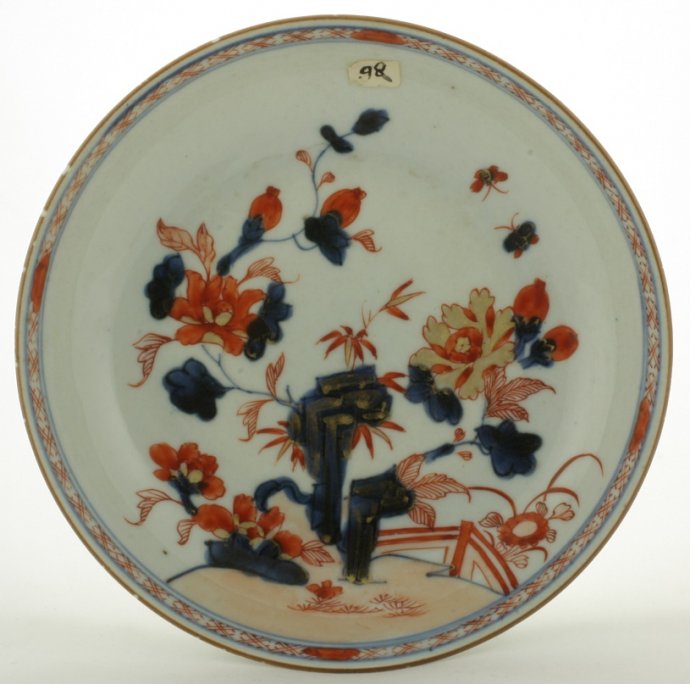
Sold Ceramics - Sold Chinese Imari 1700-1800 - Flowers, Animals and Long Elizas - Page 1
Object 2010440
Dish
China
1720-1740
Height 33 mm (1.30 inch), diameter of rim 167 mm (6.58 inch), diameter of footring 102 mm (4.02 inch)
Dish on footring, straight underglaze brown-edged rim (jia mangkou). Chinese Imari, decorated in underglaze blue, overglaze iron-red and gold with a flowering peony tree growing from rockwork near a fence with two butterflies in flight. On the rim a trellis-pattern border with four flower heads. The reverse is undecorated. On the interior wall a rectangular paper label with the handwritten number '98'.
Looking at the handwriting of the number '98', in old ink, it appears that the label was placed on the dish a long time ago. So the label itself has become part of the dish's history. Number '98' was, most likely, the dish's number in a previous owner's collection.
Condition: A few tiny fleabites to the rim.
Price: Sold.

Sold Ceramics - Sold Chinese Imari 1700-1800 - Flowers, Animals and Long Elizas - Page 1
Object 2010159
Dish
China
1720-1740
Height 26 mm (1.02 inch), diameter of rim 230 mm (9.06 inch), diameter of footring 123 mm (4.84 inch)
Dish on footring, flat underglaze brown-edged rim (jia mangkou). Chinese Imari, decorated in underglaze blue, overglaze iron-red and gold with a flowering peony and bamboo tree growing from behind a fence. On the sides a diaper-pattern border containing four cartouches filled with flowers. On the rim four flowering chrysanthemum and peony branches. The reverse is undecorated.
Condition: Three very tiny fleabites to the rim.
Price: Sold.

Sold Ceramics - Sold Chinese Imari 1700-1800 - Flowers, Animals and Long Elizas - Page 1
Objects 2010172 1-6
Six dishes
China
1720-1750
Heights 26 mm (1.02 inch), diameter of rims 230 mm (9.06 inch), diameter of footrings 123 mm (4.84 inch)
Six dishes on footrings, flat underglaze brown-edged rims (jia mangkou). rims. Chinese Imari, decorated in underglaze blue, overglaze iron-red and gold with a flowering peony tree growing from behind a fence and a flowering chrysanthemum tree growing from behind a garden wall. On the sides peony flower heads reserved on a diaper pattern ground with four reserves filled with flowering plants. On the rim two flowering chrysanthemum and two flowering peony sprays. The reverses are undecorated. Each dish with an orange number painted on its base: 1,2,3,4,5,6. On the base of dish 6 a paper label that reads "Chinees Imari 1e h. 18e E € 1.850,-".
Conditions:
Dish 1: Two fleabites to the rim.
Dish 2: A chip to the interior rim and two fleabites to the rim.
Dish 3: A chip and a firing flaw to the exterior rim.
Dish 4: A frit to the interior rim and a hairline to the rim.
Dish 5: Perfect.
Dish 6: A frit and two fleabites to the interior rim.
Reference:
Price: Sold.


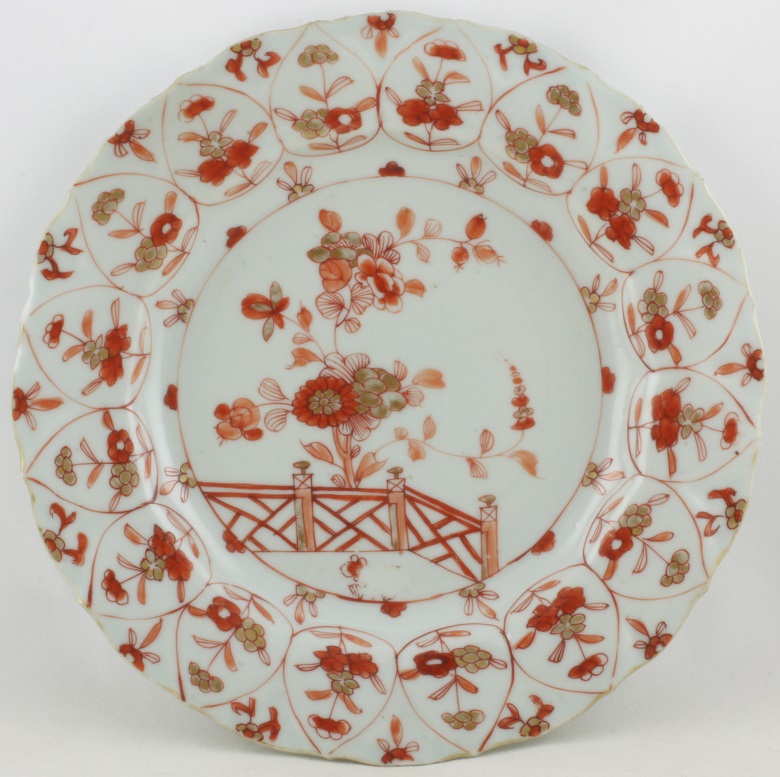
 create websites
create websites